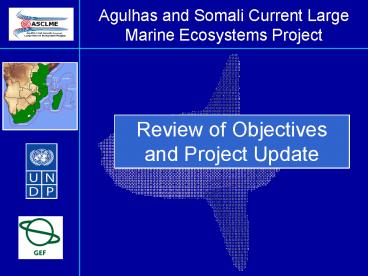Agulhas and Somali Current Large Marine Ecosystems Project - PowerPoint PPT Presentation
1 / 19
Title:
Agulhas and Somali Current Large Marine Ecosystems Project
Description:
This is a senior level person within the Focal institution (some countries have ... Coordinate research cruise requirements at the National Level ... – PowerPoint PPT presentation
Number of Views:118
Avg rating:3.0/5.0
Title: Agulhas and Somali Current Large Marine Ecosystems Project
1
Agulhas and Somali Current Large Marine
Ecosystems Project
Review of Objectives and Project Update
2
Project Details
- COUNTRIES Comoros, Kenya, Madagascar,
Mauritius, Mozambique, Seychelles, South
Africa, Tanzania (Plus Somalia where
possible) - FUNDING GEF US12.2 Million.
- Co-funding US20 Million (primarily
in-kind and from countries) - TIMEFRAME 5 Years, until mid-2012
3
ASCLME System Boundary
- The Agulhas and Somali Current Large Marine
Ecosystems
4
Project Objectives
- To undertake an environmental baseline assessment
of the Agulhas and Somali Current Large Marine
Ecosystems in order to - Capture existing information relevant to their
management - Identify and fill information gaps needed to
improve LME-based management decision-making in
the two LMEs and - Ascertain the role of external forcing functions
(such as the Mascarene Plateau and the South
Equatorial Current)
5
ASCLME PROGRAMME
- The GEF ASCLME Programme consists of three
partner projects - WIOLaB (UNEP) Addressing land-based activities
in the Western Indian Ocean (Land-based
pollution, coastal degradation, etc) - SWIOFP (World Bank) Southwest Indian Ocean
Fisheries Project addressing primarily offshore
and some near-shore commercial fisheries - ASCLME Project (UNDP) Addressing all
oceanographic aspects (biological, chemical,
physical) coastal artisanal and subsistence
fisheries, persistent organic pollutants, larval
transport, spawning and nursery areas
6
PROJECT OUTCOME 1INFORMATION CAPTURED FOR
DEVELOPMENT OF THE TRANSBOUNDARY DIAGN0STIC
ANALYSIS
- OUTPUTS
- 1.1 Review existing data available for
development of the TDAs - 1.2 Identification of gaps and data needs to
populate the TDAs - Offshore oceanographic information from priority
areas - Information on near-shore (artisanal) fisheries,
nursery areas and other biologically rich habitat
- Information on Governance (management/policy
processes) - 1.3 Active offshore data collection to fill gaps
where possible (research cruises, deployment of
moored arrays, etc) - 1.4 Baseline information on persistent organic
pollutants using key indicator species
7
PROJECT OUTCOME 2LONG-TERM DATA COLLECTION,
MANAGEMENT AND DISTRIBUTION MECHANISMS ESTABLISHED
- OUTPUTS
- 2.1 Adoption of LME-based indicators and adoption
of associated national and regional ME
mechanisms - 2.2 LME monitoring and evaluation requirements
captured within institutional work programmes and
budgets - 2.3 Socio-economic evaluation of near-shore and
marine goods and services (particularly to build
political ownership) - 2.4 Use of GIS and predictive models expanded to
increase system knowledge
8
PROJECT OUTCOME 3STRATEGIC ACTION PROGRAMME AND
SUSTAINABILITY MECHANISMS ADOPTED FOR AN LME
APPROACH
- OUTPUTS
- 3.1 TDAs and SAPs negotiated and adopted
- 3.2 Financial resources brokered to ensure the
financial sustainability of monitoring,
evaluation and information systems to support an
LME approach - 3.3 Institutional, programme and human capacity
building and training requirements prioritised
and addressed
9
PROJECT OUTCOME 4LME COORDINATION,
COMMUNICATION AND PARTICIPATION MECHANISMS
ESTABLISHED
- OUTPUTS
- 4.1 Communication/coordination established with
other related projects and institutions in the
region (including linkages to other LME
initiatives) - 4.2 Key policy-makers sensitised and engaged in
LME process - 4.3 Stakeholder engagement, public involvement,
participation, and environmental education
initiatives are developed and implemented
10
ASCLME Regional Project Management Structure
11
PROGRESS TO DATE
- Set up of PCU (Grahamstown link to SAIAB/ACEP)
- Recruitment of Admin and Technical
Staff/Consultants - Rationalisation of Project Components and
Activities - Inception/Steering Committee
- i) Adoption of realigned Components and
Activities - ii) Adoption of updated Budget and Work-plans
- iii) Confirmation of field-work priorities
- Launch of ASCLME website (in 3 languages)
- Update of ASLME Chapters on LME website
- Implementation of ASCLME National Mechanisms
- Successful completion of 1st Training Programme
(Agulhas countries) - First Cruise (East Madagascar) on-going and near
completion
12
Updates to LME website
13
ASCLME Research Cruises
14
2008 Cruise Plan (August December)
15
Project National Structure
- Each of the countries has an ASCLME National
Focal Point (designated by the Government)
through which all ASCLME information, requests
and communications are channeled in-country. - This is a senior level person within the Focal
institution (some countries have also opted for a
Technical Focal Point)
16
Project National Structure
- In addition, each country has set up national
Coordination Groups (COGs) to address - Technical Issues (includes the following
logistics people) - National Cruise Coordinator
- National Data and Information Coordinator
- National Capacity Building and Training
Coordinator - Plus Technical expertise identified for each of
the modules - Fish and Fisheries
- Productivity
- Ecosystem Health and Pollution
- Socioeconomics
- Management and Governance
17
Project National Structure
- The National Coordination Groups have Terms of
Reference to guide them. These ToR address the
need to - Coordinate the capture of data and information
for the MEDAs (and thus the regional TDAs) - Identify national capacity building training
needs - Coordinate research cruise requirements at the
National Level - Work closely with the national representatives
of SWIOFP and WIO-LaB - Raise awareness of the ASCLME process within
national institutions - Ensure effective and comprehensive in-country
stakeholder input
18
Summary of principal national COG inputs to
ASCLME Project delivery
- 1. Coordinate with the ASCLME Project and
other Projects at the national level on - a. Research Cruise Planning Implementation
- b. Capacity Building Training
- c. Data Information Management
- 2. Oversee the development of a national Marine
Ecosystem Diagnostic Analysis
19
Agulhas and Somali Current Large Marine Ecosystem
Project
THANK YOU FOR YOUR TIME































